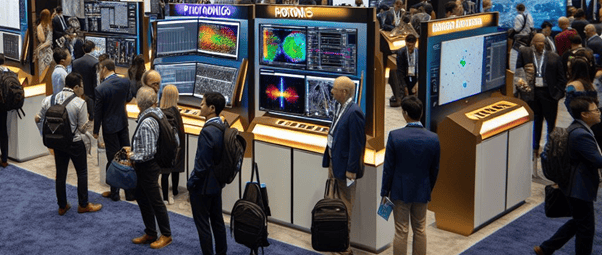PDAC 2025 Ignites a Mining Fusion: Has the Black Magic Era of AI in Mining Arrived?
Xuan-Ce Wang
3/15/20254 min read


As the world’s most influential annual mining event, PDAC 2025 turned the Toronto Convention Centre into a hub of technological upheaval! With artificial intelligence (AI) at its core, the conference showcased a full-spectrum transformation of the mining industry—from groundbreaking exploration technologies to optimized production workflows. Harnessing cutting-edge advancements like photonics, machine learning, and real-time data analytics, mining is evolving from a labor-intensive sector into a realm of intelligent decision-making systems. This report dives into five key highlights of PDAC 2025, exploring how AI is reshaping the future of mining.
1. Exploration Turns “X-Ray Vision”: AI Makes Hidden Treasures Nowhere to Hide
Photon Magic: Seeing Through 800 Meters in Just 72 Hours
Montreal’s Polytechnique unveiled its third-generation photonic sensor array, a game-changer in exploration. Using quantum cascade lasers to emit terahertz waves, it penetrates up to 800 meters below the surface, creating 3D subsurface maps. Paired with drone-mounted distributed sensor networks, exploration teams can now complete geological surveys in a mere 72 hours—a task that traditionally took three months. It’s like giving exploration a turbo boost!
45-Second Results: Teck’s Real-Time “Ore Analyzer”
Canadian mining giant Teck Resources demonstrated its real-time ore composition analysis platform, integrating X-ray fluorescence (XRF) and laser-induced breakdown spectroscopy (LIBS). Powered by edge computing, it delivers on-site results in just 45 seconds, slashing lab delays of 5-7 days by over 100 times! The platform’s deep convolutional neural network, trained on over 2 million ore samples, achieves a 99.3% accuracy rate in identifying rare metals, making blind guesswork a thing of the past.
AI “Fortune-Telling”: Barrick Boosts New Vein Discovery by 40%
The Exploration Decision Support System (EDSS) stole the spotlight at PDAC. By leveraging generative adversarial networks (GANs) and integrating satellite imagery, historical drilling data, and geological models, it predicts orebody distribution probabilities. Barrick Gold’s case study revealed a 40% increase in new vein discovery efficiency and a 28% reduction in exploration costs. Meanwhile, BMO Capital Markets introduced an intelligent exploration investment platform that uses natural language processing (NLP) to analyze 120 million geological reports, predicting deposit value with an 82% accuracy rate—far surpassing the industry’s 54% average. It’s like giving investors a crystal ball for spotting gold mines!
2. Production Goes “Unmanned”: AI Lets Machines Do the Heavy Lifting
Caterpillar’s “5G Mining Fleet Legion”
Caterpillar unveiled its intelligent mining fleet management system, orchestrating 200 machines via a 5G private network. Using federated learning, each vehicle shares operational data in real time without compromising trade secrets. A pilot in a Chilean copper mine showed a 35% boost in extraction efficiency and a 22% drop in energy consumption—a truly “unstoppable” operation.
Sandvik’s “0.03mm Precision Drilling Tech”
Sandvik’s unmanned drilling and blasting system wowed attendees with its quantum positioning chip, achieving a drilling accuracy of 0.03 millimeters. Paired with proprietary blast optimization algorithms, it improves ore fragmentation uniformity by 50%. A digital twin module simulates blast outcomes 48 hours in advance, keeping vibrations in check. This tech doesn’t just ramp up efficiency—it keeps safety on lock.
Robotic “Eyes” in Sorting: Ore Grades Don’t Even Flinch
FLSmidth’s mineral sorting robot, equipped with hyperspectral imaging, identifies 300 mineral types at conveyor speeds of 6 meters per second. Its reinforcement learning algorithm dynamically adjusts sorting strategies based on market demand. In a Canadian rare earth mine, it reduced the concentrate grade standard deviation from 1.8% to 0.3%, making ore sorting as steady as a rock.
3. Green Mining Isn’t Just Talk: AI Makes Mining Truly Sustainable
Tailings “Early Warning Radar”: 14 Days Ahead to Save Lives
Acquire Technology’s EnviroSys 4.0 platform integrates over 50 environmental sensors into an IoT network. Its time-series-based ecological warning model predicts tailings dam leaks 14 days in advance with a 91% accuracy rate. In Peru, it flagged two major risks, averting over $200 million in losses. Even cooler? It uses blockchain to store encrypted data, ensuring tamper-proof ESG reports that meet Canadian Mining Association standards.
Zero-Carbon Mines: BHP Masters Wind-Solar Storage
BHP showcased its zero-carbon mining solution, using an AI-driven microgrid to push wind-solar-storage efficiency to 92%. A multi-agent reinforcement learning algorithm optimizes energy allocation in real time, enabling 100% renewable energy use in a lithium mine in Chile’s Atacama Desert—a shining example of green mining.
Water “Recycling Wizardry”: Anglo American Cuts Usage by 65%
Anglo American’s smart water reuse system uses computer vision to monitor water quality and a Deep Q-Network (DQN) to optimize treatment. In a Namibian uranium mine, it slashed freshwater usage by 65%, with recycled water meeting drinking standards. It’s a game-changer for water-scarce regions.
4. New Rules for Global Collaboration: AI Helps Mining “Team Up”
“Smart IPOs”: TMX Drops a Game-Changer
The Toronto Stock Exchange (TMX) rolled out its “Smart Mining IPO Accelerator,” using machine learning to evaluate tech roadmaps and provide investors with dynamic risk assessments across 40 metrics. It boosts IPO pricing efficiency by 50%, ensuring capital flows to tech-driven projects without the pitfalls.
Peru’s “Encrypted Deals”: $1.2B in One Day
Peru launched a digital mining rights trading platform, leveraging federated learning to safeguard trade secrets while enabling joint modeling in a secure data space. Day one attracted 48 institutions from 23 countries, sealing $1.2 billion in intended investments—ushering global mining finance into the digital fast lane.
Sino-Global Synergy: China Minmetals’ “Silk Road Mining Cloud”
China Minmetals’ “Silk Road Mining Cloud” spans 14 countries across Asia, Africa, and Latin America. Edge intelligence gateways ensure local data processing, complying with data sovereignty laws while sharing insights via federated learning. It currently manages overseas assets worth $23 billion, giving Chinese miners a global edge.
5. Challenges and the Road Ahead: How Far Can AI Take Mining?
Ethics and Safety: AI Can’t Run Wild
McGill University’s “Responsible AI” framework stresses algorithmic transparency and human-AI collaboration. In a Congolese cobalt mine pilot, it flagged 0.7% of AI recommendations as ethically risky, averting potential controversies. The ISO’s draft “Mining AI System Certification Guidelines” mandates formal verification for control systems, set to become mandatory by 2026.
Talent Upgrade: UBC Opens a “Cheat Code”
The University of British Columbia’s “Smart Mining Engineer” program uses digital twin platforms for real-world training, with systems generating over 200 skill metrics. The first batch of grads boasts a 100% employment rate and salaries 40% higher than traditional programs. A “Human-Machine Collaboration Psychology” module boosts teamwork efficiency by 58%—the future of mining needs AI-savvy talent.
Conclusion: AI-Powered Mining—Is the Future Here?
From “X-ray vision” exploration to “unmanned” production, from environmental “early warning nets” to global “digital chains,” PDAC 2025’s AI innovations are rewriting the mining playbook. In the next five years, quantum computing and neuromorphic chips could turn mining into a knowledge-driven industry. But challenges remain: How will tech ethics take root? Can talent keep pace? Will AI make mining greener—or wilder?
Discussion: Will AI take your job? Does it make mining greener or crazier? Drop your thoughts below!
Tags: #AIProspecting #MiningRevolution #FutureIsNow








